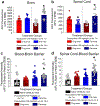Expression of Human Immunodeficiency Virus Transactivator of Transcription (HIV-Tat1-86) Protein Alters Nociceptive Processing that is Sensitive to Anti-Oxidant and Anti-Inflammatory Interventions
- PMID: 33619645
- PMCID: PMC8380260
- DOI: 10.1007/s11481-021-09985-4
Expression of Human Immunodeficiency Virus Transactivator of Transcription (HIV-Tat1-86) Protein Alters Nociceptive Processing that is Sensitive to Anti-Oxidant and Anti-Inflammatory Interventions
Abstract
Despite the success of combined antiretroviral therapy (cART) in reducing viral load, a substantial portion of Human Immunodeficiency Virus (HIV)+ patients report chronic pain. The exact mechanism underlying this co-morbidity even with undetectable viral load remains unknown, but the transactivator of transcription (HIV-Tat) protein is of particular interest. Functional HIV-Tat protein is observed even in cerebrospinal fluid of patients who have an undetectable viral load. It is hypothesized that Tat protein exposure is sufficient to induce neuropathic pain-like manifestations via both activation of microglia and generation of oxidative stress. iTat mice conditionally expressed Tat(1-86) protein in the central nervous system upon daily administration of doxycycline (100 mg/kg/d, i.p., up to 14 days). The effect of HIV-Tat protein exposure on the well-being of the animal was assessed using sucrose-evoked grooming and acute nesting behavior for pain-depressed behaviors, and the development of hyperalgesia assessed with warm-water tail-withdrawal and von Frey assays for thermal hyperalgesia and mechanical allodynia, respectively. Tissue harvested at select time points was used to assess ex vivo alterations in oxidative stress, astrocytosis and microgliosis, and blood-brain barrier integrity with assays utilizing fluorescence-based indicators. Tat protein induced mild thermal hyperalgesia but robust mechanical allodynia starting after 4 days of exposure, reaching a nadir after 7 days. Changes in nociceptive processing were associated with reduced sucrose-evoked grooming behavior without altering acute nesting behavior, and in spinal cord dysregulated free radical generation as measured by DCF fluorescence intensity, altered immunohistochemical expression of the gliotic markers, Iba-1 and GFAP, and increased permeability of the blood-brain barrier to the small molecule fluorescent tracer, sodium fluorescein, in a time-dependent manner. Pretreatment with the anti-inflammatory, indomethacin (1 mg/kg/d, i.p.), the antioxidant, methylsulfonylmethane (100 mg/kg/d i.p.), or the immunomodulatory agent, dimethylfumarate (100 mg/kg/d p.o.) thirty minutes prior to daily injections of doxycycline (100 mg/kg/d i.p.) over 7 days significantly attenuated the development of Tat-induced mechanical allodynia. Collectively, the data suggests that even acute exposure to HIV-1 Tat protein at pathologically relevant levels is sufficient to produce select neurophysiological and behavioral manifestations of chronic pain consistent with that reported by HIV-positive patients.
Keywords: Allodynia; HIV; Microglia; Oxidative stress; Pain; Tat.
© 2021. The Author(s), under exclusive licence to Springer Science+Business Media, LLC part of Springer Nature.
Conflict of interest statement
Competing interests:
The authors state they have no competing interests.
Figures





Similar articles
-
Persistent sensory changes and sex differences in transgenic mice conditionally expressing HIV-1 Tat regulatory protein.Exp Neurol. 2022 Dec;358:114226. doi: 10.1016/j.expneurol.2022.114226. Epub 2022 Sep 10. Exp Neurol. 2022. PMID: 36096180 Free PMC article.
-
A helping HAND: therapeutic potential of MAGL inhibition against HIV-1-associated neuroinflammation.Front Immunol. 2024 May 21;15:1374301. doi: 10.3389/fimmu.2024.1374301. eCollection 2024. Front Immunol. 2024. PMID: 38835765 Free PMC article.
-
Exposure to HIV-1 Tat in brain impairs sensorimotor gating and activates microglia in limbic and extralimbic brain regions of male mice.Behav Brain Res. 2015 Sep 15;291:209-218. doi: 10.1016/j.bbr.2015.05.021. Epub 2015 May 22. Behav Brain Res. 2015. PMID: 26005128 Free PMC article.
-
Tat-Based Therapies as an Adjuvant for an HIV-1 Functional Cure.Viruses. 2020 Apr 8;12(4):415. doi: 10.3390/v12040415. Viruses. 2020. PMID: 32276443 Free PMC article. Review.
-
Doxycycline-inducible and astrocyte-specific HIV-1 Tat transgenic mice (iTat) as an HIV/neuroAIDS model.J Neurovirol. 2018 Apr;24(2):168-179. doi: 10.1007/s13365-017-0598-9. Epub 2017 Nov 15. J Neurovirol. 2018. PMID: 29143286 Free PMC article. Review.
Cited by
-
Exploring viral neuropathic pain: Molecular mechanisms and therapeutic implications.PLoS Pathog. 2024 Aug 8;20(8):e1012397. doi: 10.1371/journal.ppat.1012397. eCollection 2024 Aug. PLoS Pathog. 2024. PMID: 39116040 Free PMC article. Review.
-
Effects of acute cannabidiol on behavior and the endocannabinoid system in HIV-1 Tat transgenic female and male mice.Front Neurosci. 2024 Mar 5;18:1358555. doi: 10.3389/fnins.2024.1358555. eCollection 2024. Front Neurosci. 2024. PMID: 38505774 Free PMC article.
-
Xenon gas as a potential treatment for opioid use disorder, alcohol use disorder, and related disorders.Med Gas Res. 2025 Jun 1;15(2):234-253. doi: 10.4103/mgr.MEDGASRES-D-24-00063. Epub 2025 Jan 13. Med Gas Res. 2025. PMID: 39812023 Free PMC article. Review.
-
Depressive-like Behavior Is Accompanied by Prefrontal Cortical Innate Immune Fatigue and Dendritic Spine Losses after HIV-1 Tat and Morphine Exposure.Viruses. 2023 Feb 21;15(3):590. doi: 10.3390/v15030590. Viruses. 2023. PMID: 36992299 Free PMC article.
-
Progress in Pathological and Therapeutic Research of HIV-Related Neuropathic Pain.Cell Mol Neurobiol. 2023 Oct;43(7):3343-3373. doi: 10.1007/s10571-023-01389-7. Epub 2023 Jul 20. Cell Mol Neurobiol. 2023. PMID: 37470889 Free PMC article.
References
-
- Martin C, Solders G, Sonnerborg A, Hansson P: Painful and non-painful neuropathy in HIV-infected patients: an analysis of somatosensory nerve function. Eur J Pain 2003, 7:23–31. - PubMed
-
- Phillips TJC, Brown M, Ramirez JD, Perkins J, Woldeamanuel YW, de C Williams AC, Orengo C, Bennett DLH, Bodi I, Cox S, Maier C, Krumova EK, Rice ASC: Sensory, psychological, and metabolic dysfunction in HIV-associated peripheral neuropathy: A cross-sectional deep profilng study. Pain, 2014, 155:1846–1860. - PMC - PubMed
Publication types
MeSH terms
Substances
Grants and funding
LinkOut - more resources
Full Text Sources
Other Literature Sources
Medical
Miscellaneous

